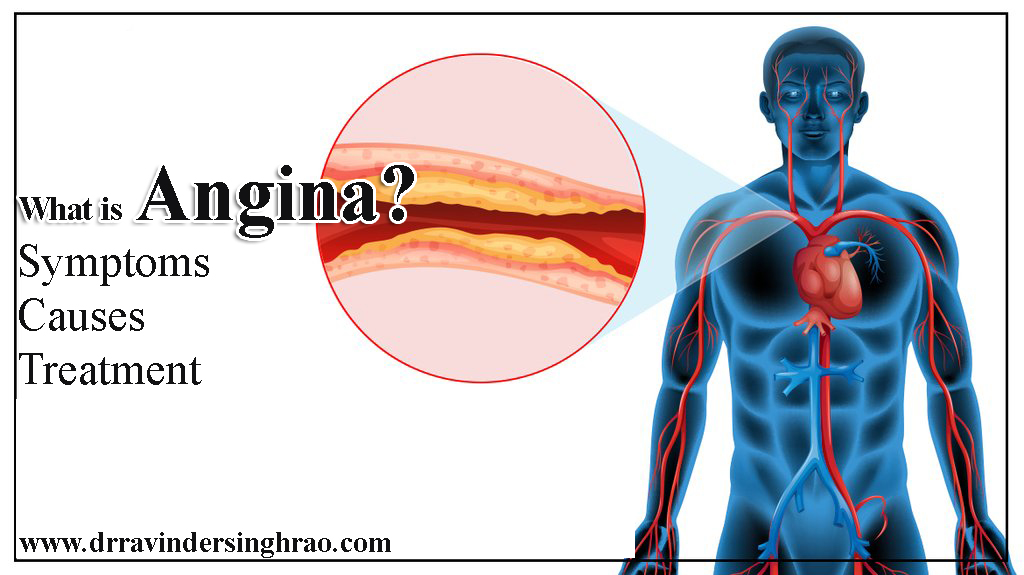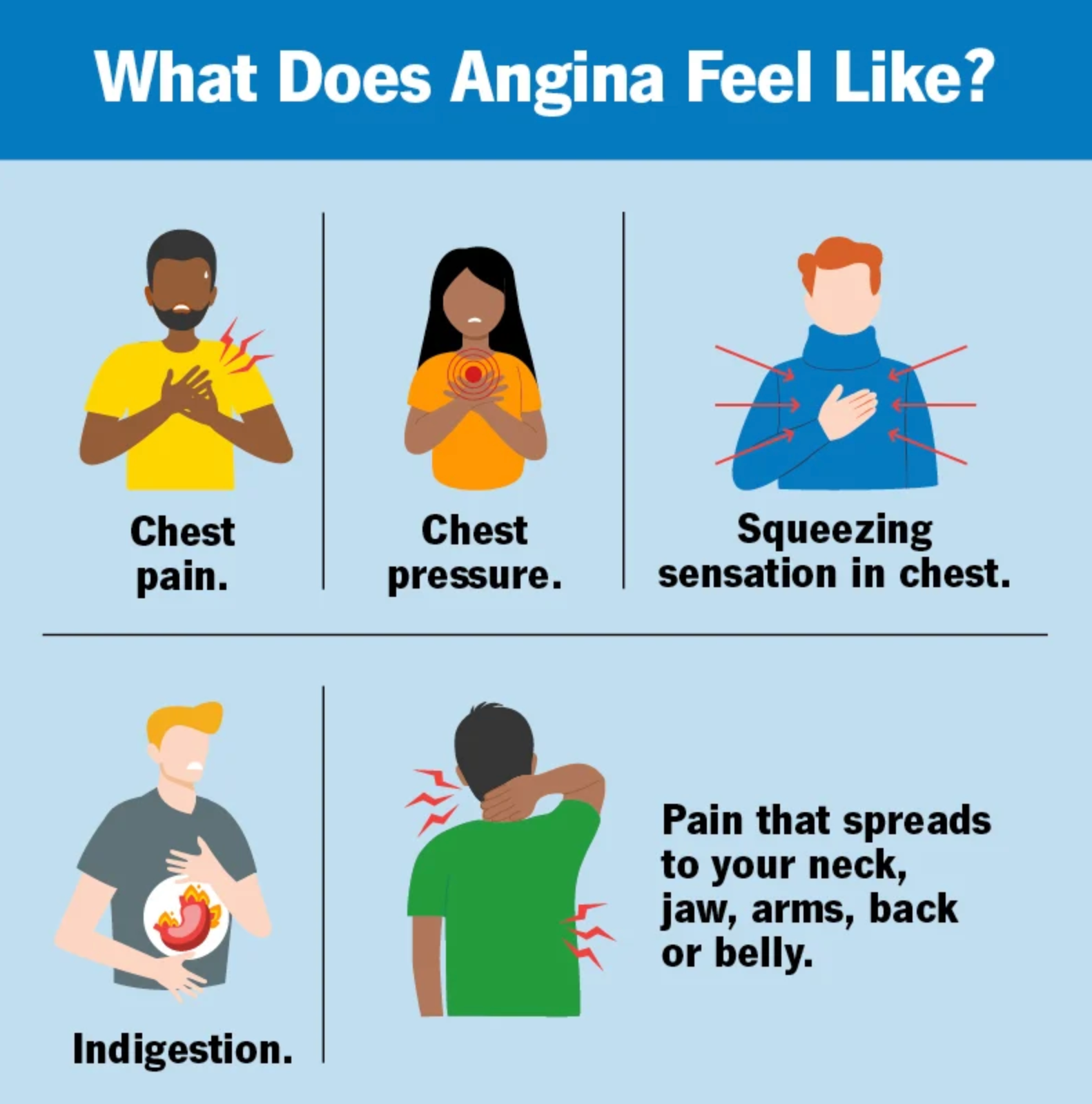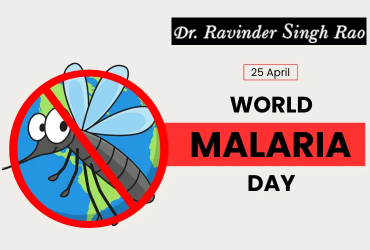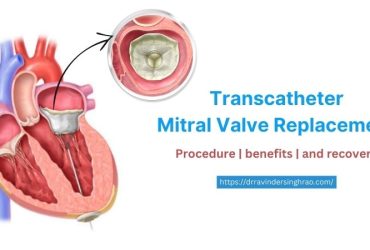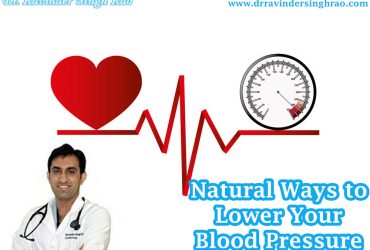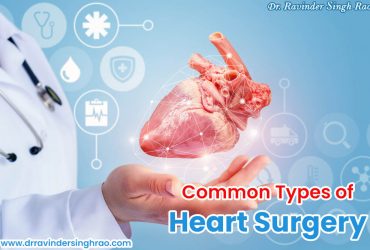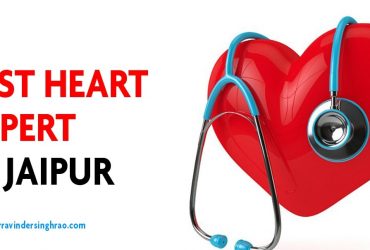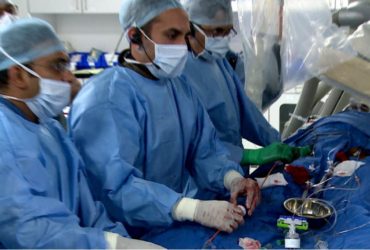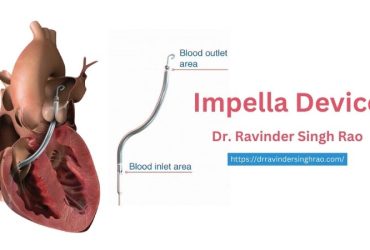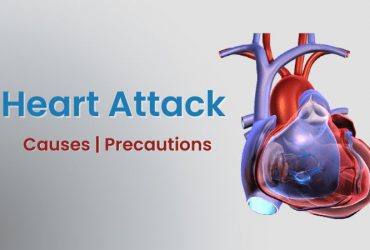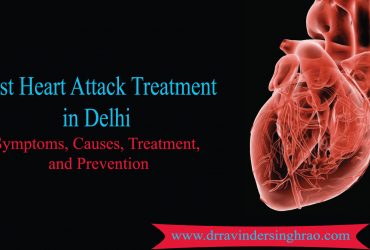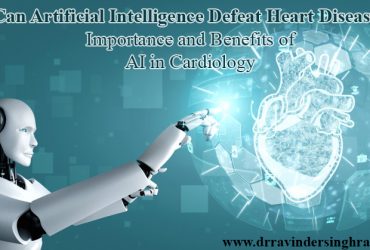Angina, also known as angina pectoris, is a common symptom of coronary artery disease (CAD), which occurs when the arteries that supply blood to the heart become narrowed or blocked. It typically occurs during physical activity, emotional stress, or after a heavy meal, and usually goes away with rest or medication.
However, if left untreated, angina can lead to a heart attack, so it is important to seek medical attention if you experience chest pain or other symptoms of angina.
What is Angina?
Angina is a discomfort or pain in the chest area caused by a blood flow decrease into the heart muscles. It usually happens when the coronary arteries are blocked, with heavy deposits, which reduce the blood flow to the heart muscles, causing a lack of oxygen, such as during physical activity. Angina isn’t a disease. It’s a symptom and a warning sign of an underlying heart condition.
These deposits narrow down the space in the arteries for proper blood supply and restrict the extended amount of blood supply to the heart muscle, thereby causing chest pain. Read this article for more information.
Important: Angina can be a warning sign of a heart attack, If you experience sudden or intense chest pain, contact emergency services immediately by dialing 9828888806 on Chest Pain Clinic.
What Does Angina Feel Like?
The typical description of angina by most people is chest pain or pressure. This discomfort may also manifest as a squeezing sensation or tightness in the chest, and some individuals may liken it to indigestion. However, for some, angina may be challenging to articulate.
The chest pain often originates behind the breastbone and can sometimes be difficult to pinpoint. The pain may also radiate to other areas of the upper body, such as the neck, shoulders, jaw, arms, back, or belly.
When the heart receives insufficient oxygen, it can result in other symptoms called “angina equivalents.” These symptoms do not feel in the chest and may include:
- Fatigue
- Nausea or Vomiting
- Shortness of breath
- Profuse sweating.
Types of Angina
Dr. Ravinder Singh Rao further explains how this pain feels and resembles pain or discomfort in cases of indigestion or anxiety in the thoracic area. This pain typically begins from the middle of the chest and can spread to other parts such as the neck, shoulders, back, and jaws.
There are four primary types of angina:
- Stable angina
- Unstable angina
- Microvascular angina
- Prinzmetal (variant) angina.
Take a look at the below for a quick overview of each type.
1. Stable Angina:
- Symptoms: pressure, pain, squeezing or fullness in the center of your chest that may spread to your jaw, neck, back, shoulder or arm; may feel like gas or indigestion.
- Triggers: physical exertion, strong emotions, extreme temperatures, after a big meal or any time your heart has to work harder.
- Duration: lasts five minutes or less, comes and goes in predictable patterns for at least two months.
- Relief: rest or medicine.
2. Unstable Angina:
- Symptoms: pain that feels different from usual stable angina, more severe or gets worse; may also have shortness of breath.
- Triggers: when resting or sleeping, light physical activity.
- Duration: may last more than 20 minutes, may go away and then return, not predictable.
- Relief: rest or medicine doesn’t make it go away.
3. Microvascular Angina:
- Symptoms: severe chest pain, shortness of breath, sweating or fatigue; lasts at least 10 minutes.
- Triggers: during normal daily routine, physical exertion, periods of strong emotions.
- Relief: medicine may not help right away.
4. Prinzmetal (variant or vasospastic) Angina:
- Symptoms: severe chest pain, vague pain or pressure in your lower chest; pain may spread to your neck, jaw or left shoulder; may have cold sweat, nausea, dizziness or fainting.
- Triggers: when resting or sleeping, often between midnight and 8 a.m.
- Duration: in a recurrent pattern.
- Relief: medication relieves pain.
Additional information:
- Stable and unstable angina are symptoms of coronary artery disease.
- Microvascular angina is a symptom of coronary microvascular disease.
- Prinzmetal angina is the least common form of angina and affects people who are younger compared to other forms of angina. It is a symptom of a coronary spasm.
Symptoms, severity, and occurrence of these different types might vary in angina. You can also visit the best angioplasty expert and cardiologist in India.
What is Angina Pectoris?
Stable angina, also known as angina pectoris, is characterized by recurring chest pain or discomfort that comes and goes in a predictable pattern.
Angina Symptoms
Typical angina symptoms include chest pain and discomfort. However, this feeling of discomfort may feel like the following:
- Burning sensation
- Feeling of fullness
- Pressure on the chest causes uneasiness
- Radiated pain in shoulders, back, jaws, and back.
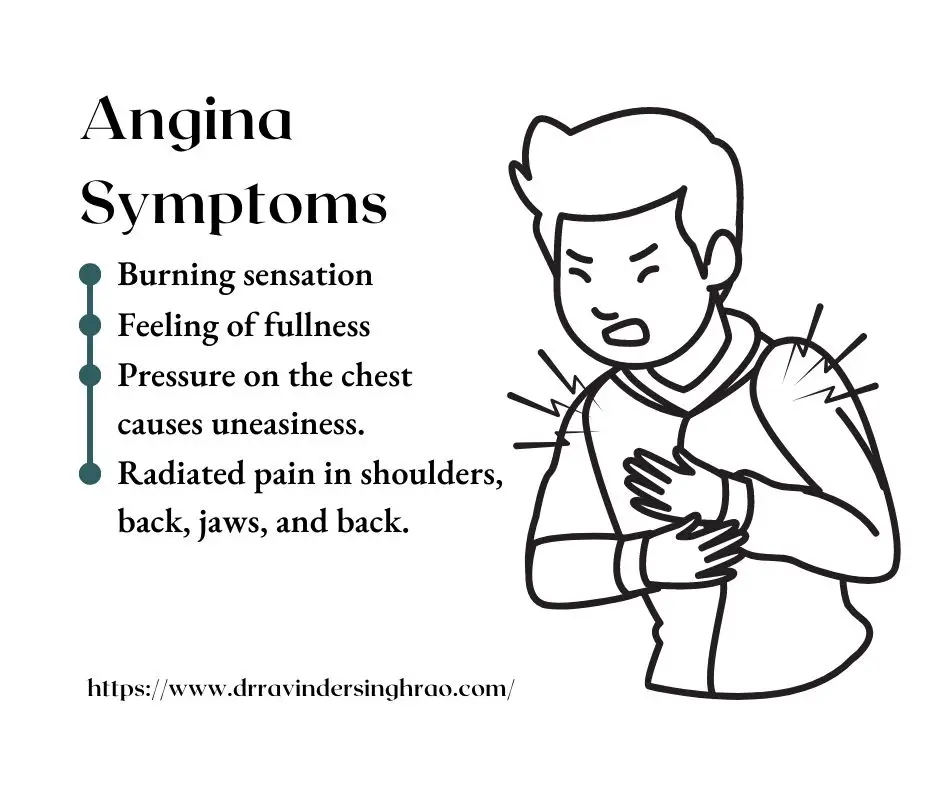
Other than these angina symptoms, a few more symptoms are to be detected if they occur:
- Feeling of dizziness
- Nausea and vomiting
- Increased sweating, especially when the pain begins
- Difficulty or shortness of breath.
Angina Causes
Here you will find What causes Angina? Insufficient blood supply to the heart muscle, known as myocardial ischemia, can cause the development of angina. There are various issues related to the coronary arteries that can impede blood flow to the heart, including:
1. Coronary artery disease (CAD): The most frequent cause of angina is coronary artery disease (CAD), a condition that occurs when plaque, a fatty substance, accumulates in the coronary arteries that supply blood to the heart. This buildup of plaque leads to a narrowing or hardening of the arteries, a process known as atherosclerosis, which results in a decrease in blood flow to the heart.
2. Coronary microvascular disease: Another cause of angina is a coronary microvascular disease, which is more commonly found in women and individuals assigned female at birth (AFAB) than in men and individuals assigned male at birth (AMAB). This condition damages the walls of small blood vessels that extend from the coronary arteries, which aren’t visible on standard CAD testing and require specialized testing that’s not available at every medical center.
3. Coronary artery spasm: Coronary artery spasm is another possible angina cause, where the coronary arteries repeatedly constrict and then dilate. These spasms temporarily restrict blood flow to the heart, and it’s feasible to experience them without having CAD. Such spasms may not be diagnosed during routine CAD testing and may require specialized testing that’s not available at every medical center.
Risk Factors for Angina
Numerous risk factors can increase the likelihood of developing angina. Certain factors elevate the risk of heart conditions that cause angina directly, such as coronary artery disease. Other factors restrict the amount of oxygen-rich blood that can reach the heart.
Some risk factors, like aging, cannot be modified, but others can be managed through changes in lifestyle and medication. Discuss with your healthcare provider the options to reduce your risk of angina.
The following factors increase the risk of angina:
- Anemia (low red blood cells)
- Chronic stress
- Diabetes
- A diet high in saturated fat, trans fat, sugar, sodium, or refined carbohydrates
- Drinking excessive amounts of alcohol
- Exposure to “particle” air pollution, like dust from roads, farms, or construction sites
- A family history of early heart disease
- Heart failure
- Heart valve disease
- High blood pressure
- High cholesterol
- Hypertrophic cardiomyopathy (enlarged heart)
- Inflammation
- Long-term exposure to secondhand smoke
- Metabolic syndrome
- Physical inactivity
- Obesity
- Older age (over 45 for men and individuals assigned male at birth, over 55 for women and individuals assigned female at birth)
- Smoking, vaping, or using other tobacco products
- Use of street drugs.
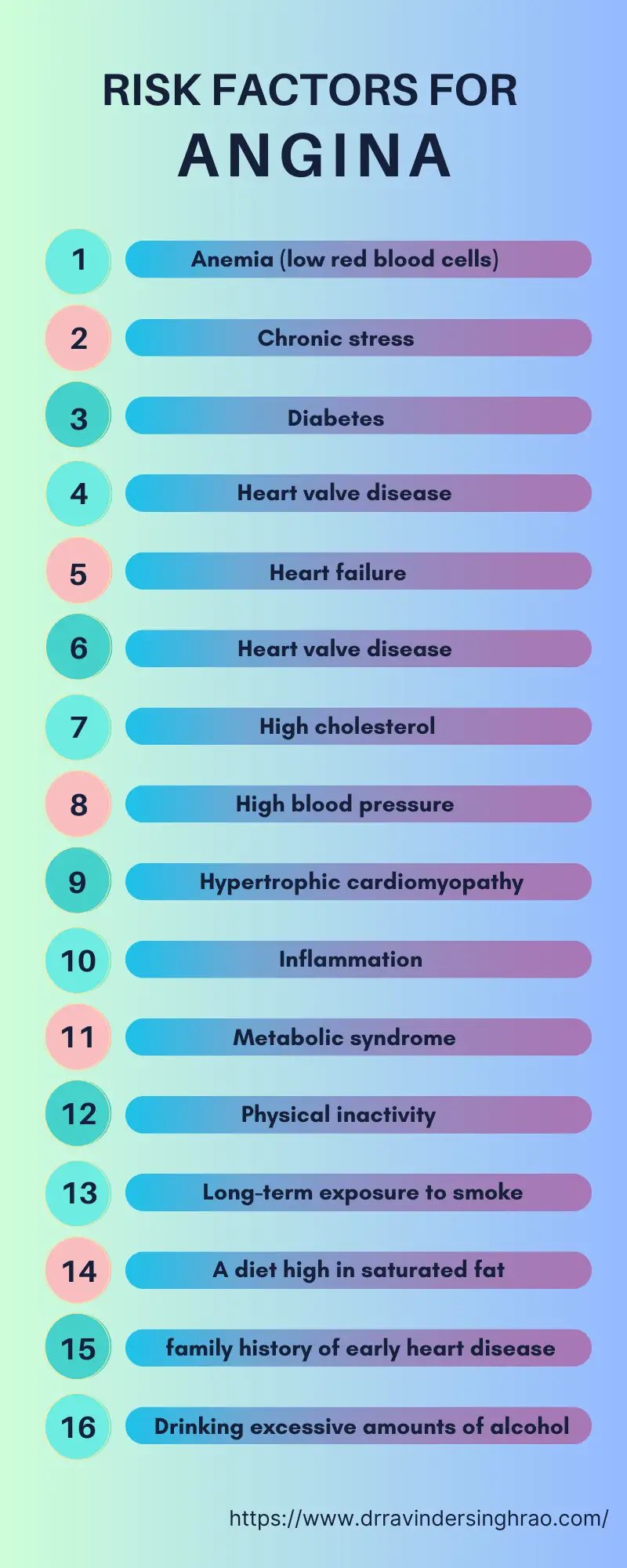
Angina Treatment – How is Angina Treated?
When you seek medical care for angina, Dr. Ravinder Singh Rao will aim to address the root cause of your condition, typically an underlying heart problem. The primary objectives of treatment are to enhance blood flow to your heart and reduce your risk of complications.
Dr. Ravinder Singh Rao will begin by conducting a physical examination and performing diagnostic tests to evaluate your condition and identify appropriate treatment options. Based on the results of these tests, Dr. Ravinder Singh Rao will develop a personalized treatment plan to address your specific needs and optimize your heart health.
The angina treatment includes physical examination and tests to examine the actual condition. That is followed by medication, depending upon the body’s requirements. If there are plaques deposited in the arteries, cholesterol treatment is provided.
Several treatment options are available to manage angina, including:
- Anticoagulants or antiplatelet drugs to decrease the likelihood of blood clots.
- Blood pressure medications to control high blood pressure.
- Cholesterol medications to lower high cholesterol levels.
- Medications specifically designed to treat angina.
- Lifestyle changes, such as quitting smoking, maintaining a healthy diet, and regular exercise.
- Coronary artery bypass grafting (CABG), a surgical procedure that bypasses blocked coronary arteries.
- Percutaneous coronary intervention (PCI), also known as coronary angioplasty and stenting, a minimally invasive procedure that widens narrowed coronary arteries.
Even with proper treatment, some individuals may still experience angina. Your healthcare provider may prescribe medication, such as nitroglycerin, to rapidly open up your blood vessels during an angina episode.
Enhanced external counterpulsation (EECP) is an additional option for individuals experiencing persistent angina. This non-invasive therapy applies pressure to the lower legs to increase blood flow to the heart, potentially easing angina symptoms.
What Can I do at Home to Manage Angina?
It is important to discuss with Dr. Ravinder Singh Rao for how to manage angina in your daily life. Based on the type and cause of your angina, your provider will give you personalized advice. Here are some general tips that may be helpful:
- It is useful to keep a record of your angina episodes. Note down the date and time, describe the symptoms and possible triggers, such as activities, emotions, or weather. Also, include the level of pain on a scale of 1 to 10. Share this log with your provider to help them better understand your condition.
- Knowing when to seek emergency help is crucial. Your provider can advise you on what to do in case of an angina attack.
- Taking medication as prescribed is essential to manage angina symptoms. Be sure to follow your provider’s instructions and take medication regularly.
- Try to avoid activities that may trigger an angina attack. Discuss with your provider which activities are safe for you. Many people with angina can continue their regular routine but may need to carry medication with them in case of an emergency. You may also need to reduce heavy lifting or other strenuous tasks that could trigger an angina attack.
- If you have concerns about specific activities, such as driving, exercising, playing sports or working a physically demanding job, talk to Dr. Ravinder Singh. They can provide guidance based on your individual situation and help you safely participate in the activities you enjoy.
How Can I Prevent Angina?
Living a heart-healthy lifestyle is a crucial step in preventing angina. By taking the following measures, you can significantly improve the health of your heart:
- Say no to smoking and all tobacco products, as well as exposure to secondhand smoke. The toxic chemicals in these products can harm your heart and blood vessels, leading to angina and other health problems.
- Follow a heart-healthy diet by choosing foods that are low in saturated and trans fats, sugar, and sodium. The DASH Diet and the Mediterranean Diet are excellent options to consider. Incorporating plenty of fruits, vegetables, whole grains, lean protein, and healthy fats into your diet can also benefit your heart.
- Manage stress levels by trying out stress-reducing techniques such as meditation, yoga, or talking to a counselor or friend. Writing in a journal can also help you process your emotions and concerns effectively.
- Maintain a healthy weight by consulting with your healthcare provider about your ideal weight and seeking their advice on how to achieve and maintain it. Carrying excess weight can put undue pressure on your heart, leading to complications such as angina.
- Control risk factors for coronary artery disease, such as high blood pressure, high cholesterol, high triglycerides, and diabetes. By monitoring and controlling these conditions with medication and lifestyle changes, you can prevent or minimize the risk of angina.
- Incorporate physical activity into your routine by aiming to exercise for at least 150 minutes (2.5 hours) every week. Walking, cycling, swimming, or engaging in other physical activities you enjoy can help strengthen your heart and reduce the risk of angina.
- Take medications prescribed by your cardiologist as directed. These medications have been proven to reduce or eliminate angina symptoms and protect your heart from further damage. It’s essential to follow your healthcare provider’s recommendations to maintain your heart health.
Video: Chest Pain Clinic
Conclusion
Angina is a prevalent symptom of heart disease, and it’s crucial to learn how to manage it effectively. Understanding your triggers, such as physical activity or stress, and knowing when to take medication or rest can help control your angina symptoms. By adopting healthy lifestyle habits like regular exercise, a heart-healthy diet, and avoiding tobacco products, you can reduce the risk of angina and improve your heart health.
However, it’s essential to remember that angina can sometimes indicate a more severe condition like a heart attack. Knowing when to seek emergency medical help can be lifesaving.
There are various types of angina-specific medicines provided by heart experts to control angina symptoms and conditions in the body. In cases with damage to the heart muscles, surgeries are advised, such as coronary angioplasty and stenting. You can consult with the best Cardiologist and heart expert in Jaipur for further assistance and treatment.
Hence, visit the best cardiologist, and angioplasty expert, Dr. Ravinder Singh Rao, if pain occurs frequently. He is the best heart disease expert in Jaipur, India. For more, you can also contact us on the emergency helpline number +91-7891791586

